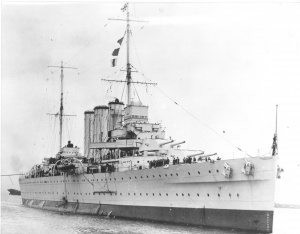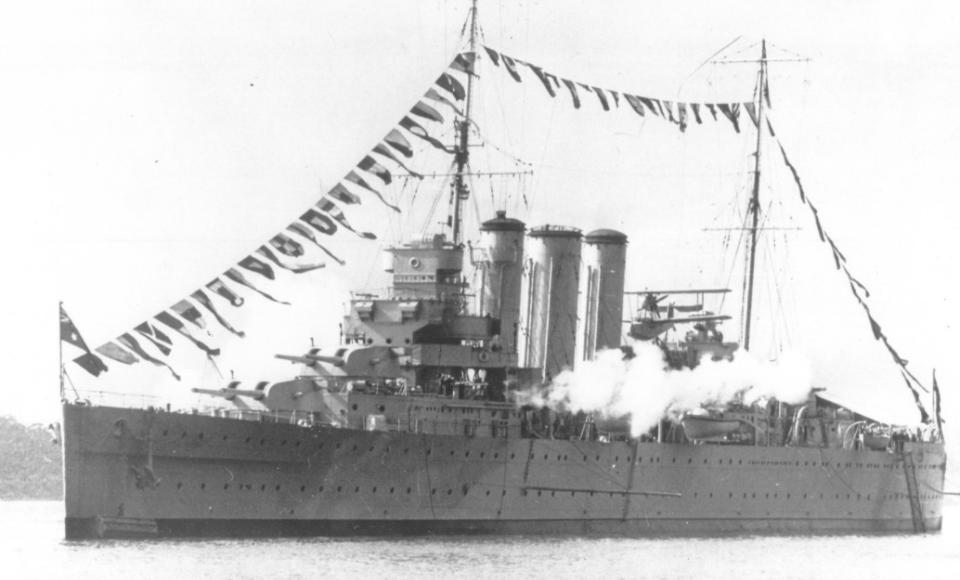HMAS Canberra (I) was a 10,000-ton County-class heavy cruiser. In the Second World War, it served as an escort and patrol ship in the oceans surrounding Australia and in the South West Pacific area of operations. Canberra took part in the US-led campaigns at Guadalacanal and Tulagi, where it was sunk in the 1942 Battle of Savo Island.
Canberra was one of two Kent-Class variants of the County-Class cruisers ordered by the Australian government under a five-year naval development program from 1924 to 1929. Its sister ships were HMAS Australia and HM Ships Kent, Berwick, Cornwall, Cumberland and Suffolk. Canberra was commissioned at Clydebank (near Glasgow) on 9 July 1928 under the command of Captain George L Massey RN.
After five months in British waters, Canberra sailed from Portsmouth for Australia on 4 December 1928. It arrived at Fremantle on 25 January 1929. The cruiser remained in Australian waters until September 1931, when it made its first voyage outside the Australia Station: to New Caledonia and Fiji. For several periods in the 1903s, Canberra was the flagship of the Australian Squadron. It visited the China Station in 1932 and 1937, and made three visits to New Zealand ports. Canberra escorted the Duke of Gloucester’s ship during his visit in 1934.
Canberra spent the first nine months of the Second World War patrolling and escorting in home waters and the Tasman Sea under the command of Captain Wilfrid R Patterson CVO RN. In June 1940, Captain Harold B Farncomb MVO RAN assumed command. In July, Canberra began a period of escort duties in the Indian Ocean.
Although most searches for raiders were unsuccessful, in March 1941 Canberra’s luck changed. While patrolling with HMS Leander (of the New Zealand Division of the Royal Navy), Canberra intercepted the German supply ship Coburg while it was being replenished at sea by the ex-Norwegian tanker Ketty Brovig. The raider Atlantis had taken the tanker in prize in the preceding month. Ignoring signals to stop, the ships parted and headed in opposite directions. Shells from Canberra started a fire aboard Coburg while Canberra’s aircraft bombed Ketty Brovig. The ships were stopped, but the crews of both vessels had opened the seacocks and were abandoning ship. Coburg sank before it could be boarded. Leander picked up the crew. Ketty Brovig was successfully boarded but had taken on too much water to be saved. The loss of the supply ship and tanker disrupted German raider operations.
In the second half of 1941, Canberra operated in the eastern Indian Ocean and the Tasman Sea. When Japan entered the war, Canberra was berthed in Sydney. The ship quickly commenced duties: convoying troops to New Guinea in January 1942 and escorting convoys to the Malaya-Java theatre. On 7 February 1942 it docked in Sydney for extensive refit work that was not completed until mid-May. Canberra lay at anchor in Sydney harbour on the night of 31 May-1 June 1942, when Japanese midget submarines raided.
Captain Frank E Getting RAN assumed command of Canberra in June 1942. In the same month, Canberra took part in offensive sweeps in the Coral Sea as part of Task Force 44. The cruiser operated with the naval force supporting the American landings at Guadalcanal and Tulagi in August. Damage inflicted on Canberra in the Battle of Savo Island, led to the cruiser being sunk.
Struck by two torpedoes on her starboard side and over 20 salvoes of 8-inch shellfire, Canberra lost power and was listing. The wounded and survivors were transferred to US Ships Patterson and Blue. Rear Admiral RK Turner USN ordered that Canberra be abandoned and sunk if it could not steam by 06:30. In accordance Turner’s orders, and with the agreement of the tactical commander for operations at Guadalcanal, USS Selfridge fired 263 5-inch shells and four torpedoes into Canberra—but did not sink it. At about 08:00 on 9 August 1942, USS Ellet fired a torpedo at Canberra. The cruiser then sank.
The enemy action against Canberra made nearly a quarter of the ship’s complement casualties. Nine officers and 65 sailors were missing believed killed. These included one Royal Australian Air Force (RAAF) officer, one US Navy officer, three RAAF enlisted personnel and two Royal Navy sailors. Captain Getting, eight sailors and an enlisted member of the RAAF died of wounds. Ten officers (including one from the Royal Navy), 96 sailors (including two RAAF personnel and two US Navy sailors) and three civilian canteen staff were wounded.
Out of respect for Canberra, the US Navy named a Baltimore-class heavy cruiser ‘Canberra’ in 1943. It was the only US Navy ship to be named for a foreign capital. On 22 July 2023, the second USS Canberra was commissioned at the RAN’s Fleet Base East in Sydney. The new USS Canberra, a multihulled littoral combat ship, was built by Austal USA, a subsidiary of the Australian shipbuilder, Austal.
Specifications
 |
| Class |
County Class |
|---|---|
| Type |
Heavy Cruiser |
| Pennant |
D33 |
| Builder |
John Brown & Co Ltd, Clydebank, Scotland |
| Laid Down |
9 September 1925 |
| Launched |
31 May 1927 |
| Launched by |
Her Royal Highness Princess Mary |
| Commissioned |
9 July 1928 |
| Decommissioned |
9 August 1942 |
| Fate |
Lost in action on 9 August 1942 |
| Dimensions & Displacement | |
| Displacement | 9850 tons |
| Length | 630 feet (overall) |
| Beam | 68 feet 4 inches |
| Draught |
|
| Performance | |
| Speed | 31½ knots |
| Complement | |
| Crew | 679 (710 as flagship) |
| Propulsion | |
| Machinery | Brown-Curtis geared turbines, 4 screws |
| Horsepower | 80,000 |
| Armament | |
| Guns |
|
| Awards | |
| Battle Honours |
|
